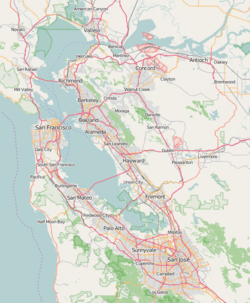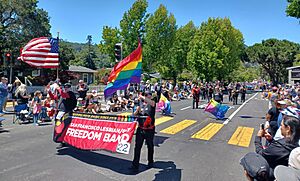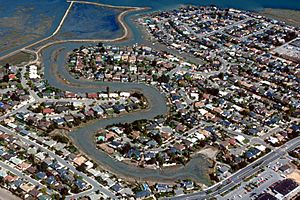Corte Madera, California facts for kids
Quick facts for kids
Corte Madera
|
||
|---|---|---|
| Town of Corte Madera | ||
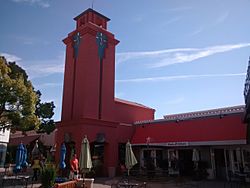
Corte Madera Town Center
|
||
|
||
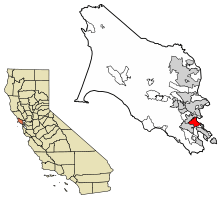
Location of Corte Madera in Marin County, California
|
||
| Country | ||
| State | ||
| County | Marin | |
| Incorporated | June 10, 1916 | |
| Area | ||
| • Total | 4.40 sq mi (11.40 km2) | |
| • Land | 3.16 sq mi (8.18 km2) | |
| • Water | 1.24 sq mi (3.22 km2) 28.19% | |
| Elevation | 39 ft (12 m) | |
| Population
(2020)
|
||
| • Total | 10,222 | |
| • Density | 3,234.81/sq mi (1,248.89/km2) | |
| Time zone | UTC−08:00 (PST) | |
| • Summer (DST) | UTC−07:00 (PDT) | |
| ZIP Codes |
94925, 94976
|
|
| Area codes | 415/628 | |
| FIPS code | 06-16462 | |
| GNIS feature IDs | 277492, 2413247 | |
Corte Madera (/ˈkɔːrtə məˈ[unsupported input]ə/) is a town in Marin County, California. Its name comes from a Spanish phrase meaning "Chop Wood."
The town is located about 3.25 miles (5.2 km) south of San Rafael. It sits at an elevation of 39 feet (12 meters) above sea level. In 2020, about 10,222 people lived there. Corte Madera was named this because the area was famous for its redwood tree lumber. This wood was used to help build the city of San Francisco.
Contents
About Corte Madera's Location
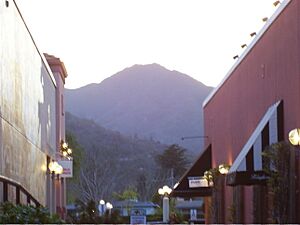
Corte Madera is located in Marin County, California. It has a total area of 4.4 square miles (11.4 square kilometers). Most of this area is land, about 3.2 square miles (8.2 square kilometers). The rest, about 1.2 square miles (3.2 square kilometers), is water. This means about 28% of the town's area is water.
Corte Madera's History
Early Days and Lumber
The first post office in Corte Madera opened in 1878. It closed briefly but reopened in 1902 under the name "Adams." Later that year, it was renamed Corte Madera. The town officially became a city in 1916.
Corte Madera is built on land that was once part of a large ranch. This ranch was given to John Reed in 1834. Reed quickly started a lumber business. He cut down many redwood trees and sent the wood to San Francisco. Some of this wood was used to build the Presidio in San Francisco.
Growth and Railroads
When California joined the United States in 1850, more people moved to the area. By 1875, the North Pacific Coast Railroad built tracks through Corte Madera. This allowed lumber to be easily transported. Later, passenger trains carried people to and from San Francisco. Many people used the Sausalito ferry to connect with the trains.
In 1885, a lawyer named Frank Morrison Pixley helped create the first housing area in Corte Madera. He is also known for developing the downtown area. The town's population grew a lot, especially after the Golden Gate Bridge was finished in 1937.
Historic Buildings and Town Square
The first business building in Corte Madera was a hotel and tavern. It was built in 1898 by Jerry Adams. This three-story building is still standing today on First Street. It now has a beauty salon and apartments.
A large barn was built in 1898 across from the train station. It was first used for horses to carry goods. Later, it became a general store for 50 years. Today, this barn is a spa and beauty salon.
Many other old buildings still stand. The Holy Innocents church, built in 1901, is still there. The Presbyterian Church, built around the same time, also remains. These buildings show the history of the town.
The area around the train station was the original center of Corte Madera. Railroad Park was established here in 1916. It was later renamed Menke Park. Many homes built around this time show a New England style of architecture.
The hill at the base of Corte Madera is called Christmas Tree Hill. This is because the street lights and homes on the hill look like a lighted Christmas tree at night.
Fun Community Events
Fourth of July Celebration
Corte Madera and its nearby "twin city," Larkspur, have a big Fourth of July celebration. Thousands of people come to watch. The event includes a parade through Old Town. There are also fun activities and a picnic in the Town Park. Local baseball teams often march in the parade.
Past Traditions
From the 1950s to the early 1970s, Holy Innocents Episcopal Parish held a special event. It was an Epiphany pageant with children singing. After the pageant, there was a Christmas tree bonfire outside the church. People would bring their old Christmas trees, and the fire department would watch over the burning. This tradition ended in the 1970s.
People of Corte Madera
| Historical population | |||
|---|---|---|---|
| Census | Pop. | %± | |
| 1920 | 607 | — | |
| 1930 | 1,027 | 69.2% | |
| 1940 | 1,098 | 6.9% | |
| 1950 | 1,933 | 76.0% | |
| 1960 | 5,962 | 208.4% | |
| 1970 | 8,464 | 42.0% | |
| 1980 | 8,074 | −4.6% | |
| 1990 | 8,272 | 2.5% | |
| 2000 | 9,100 | 10.0% | |
| 2010 | 9,253 | 1.7% | |
| 2020 | 10,222 | 10.5% | |
| U.S. Decennial Census | |||
In 2010, Corte Madera had a population of 9,253 people. Most residents, about 84.4%, were White. About 6.8% were Asian, and 8.3% were Hispanic or Latino.
There were 3,793 households in the town. About 35.5% of these households had children under 18 living in them. The average household had 2.44 people. The average family had 2.99 people.
The population included people of all ages. About 25.2% were under 18 years old. About 16% were 65 years or older. The average age in Corte Madera was 44.2 years.
Economy and Shopping
Corte Madera is home to the headquarters of some well-known companies. These include Restoration Hardware and Il Fornaio.
The town also has two main shopping centers. They are called The Village at Corte Madera and Town Center at Corte Madera. These malls offer many stores and restaurants.
The Old Corte Madera Town Square has historic buildings and local shops. You can find hair salons, consignment stores, and art classrooms there.
Schools in Corte Madera
Public Schools
Most students in Corte Madera attend schools in the Larkspur-Corte Madera School District.
- Neil Cummins Elementary School serves students from kindergarten to 5th grade.
- Hall Middle School serves students from 6th to 8th grade.
- The Cove School is a newer elementary school. It serves neighborhoods mostly west of Highway 101.
For high school, students attend Redwood High School in Larkspur. This school is part of the Tamalpais Union High School District.
Private Schools
Marin Country Day School is a private school located in Corte Madera.
A campus of the Lycée Français de San Francisco (a French school) used to be in Corte Madera. It moved to nearby Sausalito in 2013.
See also
 In Spanish: Corte Madera (California) para niños
In Spanish: Corte Madera (California) para niños



